Thiago Motta Style Of Play
A few seasons back, Thiago Motta raised some eyebrows of curiosity in the football world by revealing his idea for a 2-7-2 formation, something which has never been seen before, at least not since the early 1900s when supposedly nobody cared about defending.
Some chuckled at this admission, many were even concerned, but the vast majority were intrigued about how such a setup would work at the highest level.
However, Motta had merely labelled the 4-3-3 by breaking the structure down horizontally rather than vertically, which is certainly not commonplace in the game.
Using a fullback and a winger on both sides, as well as seven players in the central areas, Motta’s quantification of the conventional shape was just an unorthodox way of characterising a 4-3-3, essentially looking at the formation sideways.
Nevertheless, the young coach is still making a name for himself in the game.
A disciple of Louis van Gaal, Frank Rijkaard, Jose Mourinho and Unai Emery, Motta is already on his fourth club since taking the leap into management.
Following his departure from Spezia in the summer, the 40-year-old is now at the helm of Bologna, tasked with restabilising the ship after Siniša Mihajlović was dismissed in the first week of September due to the Rossoblù’s woeful start to the Serie A campaign.
With an attacking philosophy, Motta has begun implementing his vision at the Stadio Renato Dall’Ara just four games into his tenure.
This piece will be a tactical analysis of Bologna under Motta.
It will be an analysis, breaking down Thiago
Motta’s tactics, which the two-time UEFA Champions League winner has deployed thus far in hiswinless start to his reign.
Thiago Motta Preferred formation
While Motta has advocated for the 4-3-3 in the past, the Italian has favoured the 4-2-3-1 in recent years.
Regardless, Serie A’s second-youngest coach has not been as stubborn as Mihajlović despite the dismal start to the season.
At Spezia, Motta really showed his tactical flexibility, which is becoming increasingly important for top-level coaches in the modern game because of the rapidly evolving tactical demands within the sport.
While the 4-2-3-1 was still Spezia’s primary shape for the entirety of the 2021/22 campaign under his tutelage, Motta was not afraid to switch things up, even employing his preferred 4-3-3/4-1-4-1, as well as the 4-4-2 along with several variations of back-three formations.
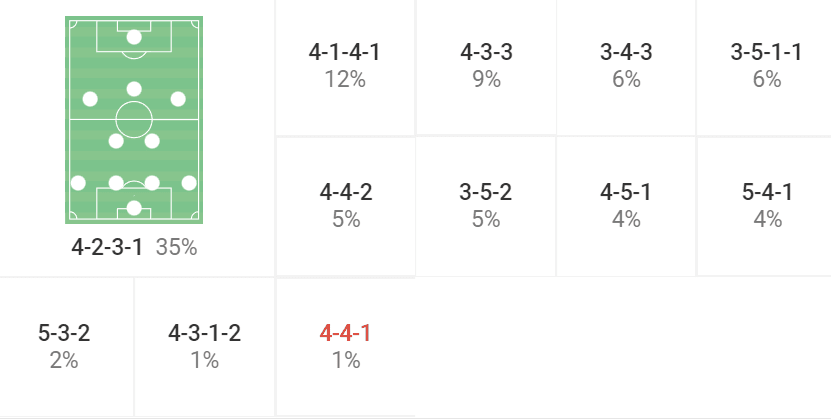
Upon accepting the job in Northern Italy, Motta took over a team that had mainly used the 3-5-2 during Mihajlović’s reign.
This is something that the coach looked to change instantly.
The team had set up in the 3-5-2 in the final game before Motta took the reins, so the vibrant manager went with a 4-2-3-1 from the get-go.
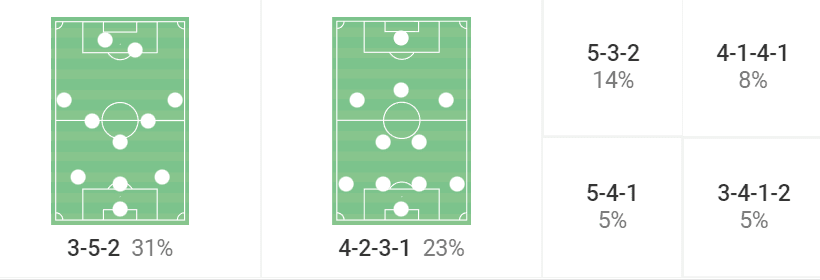
The graphic above displays Bologna’s formations from the 2022/23 campaign so far.
While Mihajlović’s 3-5-2 reigns supreme, the 4-2-3-1 is slowly creeping up percentage-wise and will likely top the charts over the next few weeks.
Despite losing his opening two matches with the Rossoblù, Motta stuck with his guns and maintained the 4-2-3-1.
It was after the disappointing draw at home to strugglers Sampdoria, led by his former Internazionale teammate Dejan Stanković, that the new boss switched things up, tweaking the shape to become a 4-1-4-1 against league-leaders Napoli in a game that Bologna were unfortunate to lose, having given Luciano Spalletti’s high-fliers a scare in the 3-2 defeat in Naples.
However, formations are not the be-all and end-all of football tactics.
Far from it.
It is the principles that Motta has installed into the team that are the most eye-catching.
So, without further ado, let’s analyse how Bologna looked tactically during Motta’s short stint.
Thiago Motta Build-up play
A massive component of Bologna’s set-up under Motta has been the coach’s emphasis on build-up play.
There are two ways to play out from the back.
A side can either play through the press or play over it.
Given that Bologna doesn’t possess as many technically gifted players as a team like Napoli or Manchester City, the manager has insisted that both methods are to be used throughout games.
Allowing the players to make direct passes forward when necessary or if under pressure when playing on the deck would be far too risky.
As always, build-up play begins with the goalkeeper, and Bologna is no exception to this rule.
Motta wants his keeper to be adept with the ball when going long and short.
Łukasz Skorupski Pass Map
Poland international Łukasz Skorupski has been tasked with being Motta’s man in this regard.
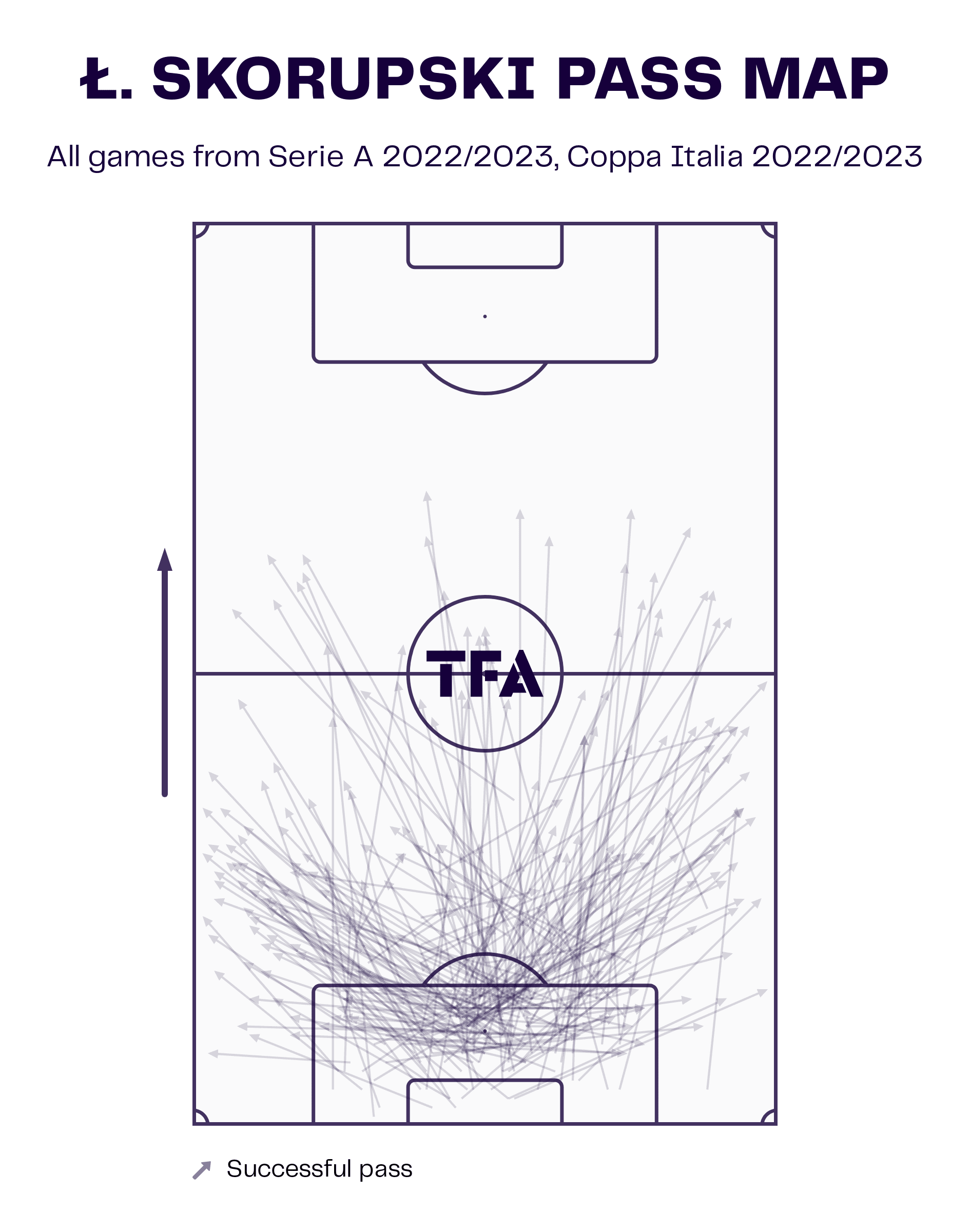
His shot-stopping ability is just as important as his deftness with the ball at his feet in order for Bologna to initiate attacks from their own penalty area.
Looking at the keeper’s pass map from this season in the data viz above, it is evident how much the 31-year-old switches between playing short to the deepest midfielder at the top of the box or to the centre-backs and going long to the target men up front when applicable.
Back three systems offer more variety from positional rotations, especially behind the opposition’s first line of pressure.
Mourinho’s AS Roma are a perfect example of this as one of the centre-backs is given license to push up beyond the opponent’s forwards to act as a progressive passing option to break the first pressing line.
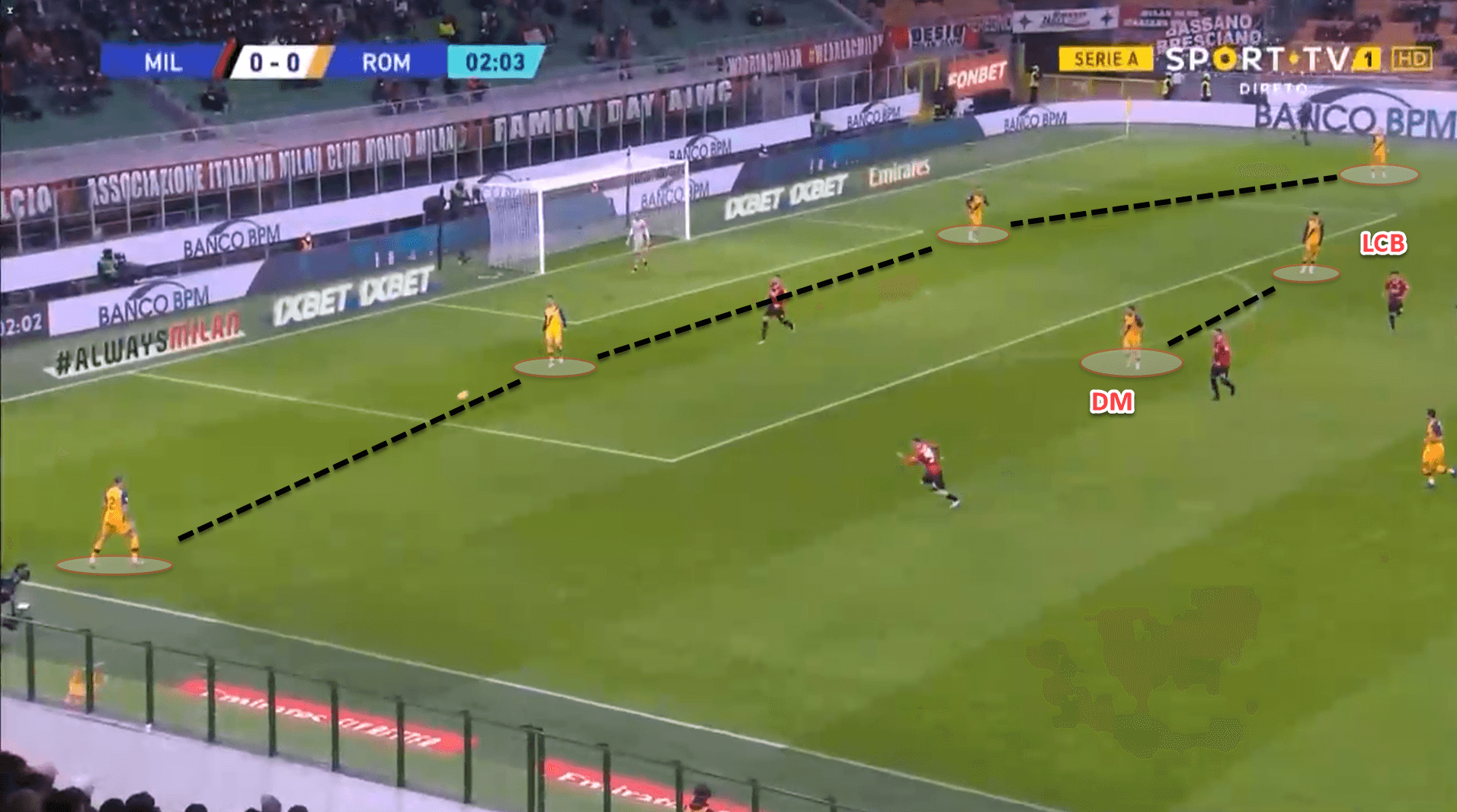
In this example from last season, the Giallorossi’s wingbacks have positioned themselves lower to create a back four while the left centre-back has moved beyond the opposition’s first line of pressure, creating a 4-2 structure.
Motta, a disciple of ‘The Special One’, has used this very same shape in the build-up phase during his time with Bologna.
However, the Rossoblù are far more rigid with this approach, given that they have primarily deployed a 4-2-3-1 anyway.
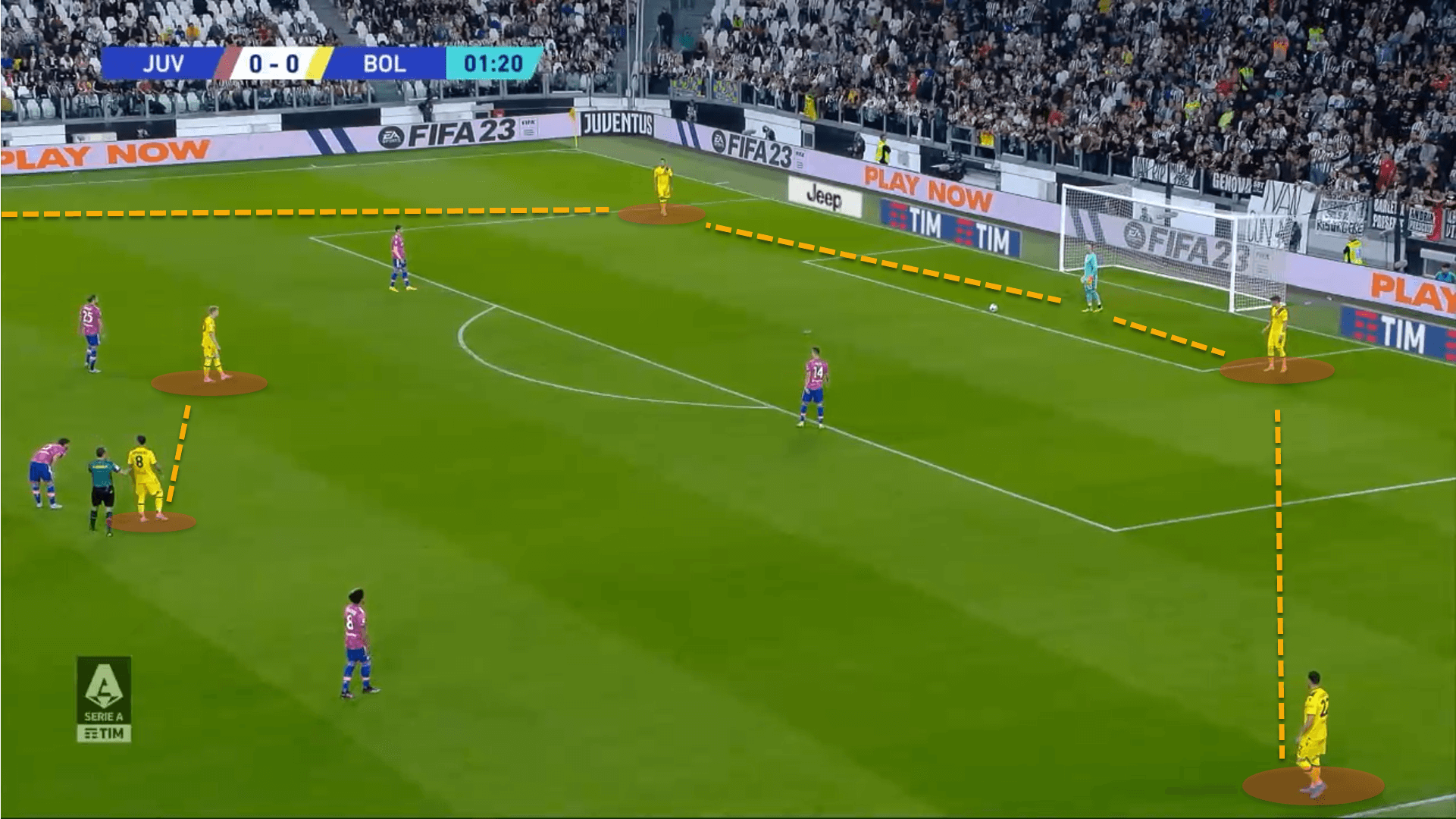
Nevertheless, there are times when Motta wants his players to change things up in order to avoid unpredictability against another side’s high pressing.
Generally, one of the pivot players will drop out to the left side to become an auxiliary fullback, allowing the wide defender on the flank to push further forward and pin back the opponent’s winger, which gives the pivot more time to receive the ball and pick out his next pass.
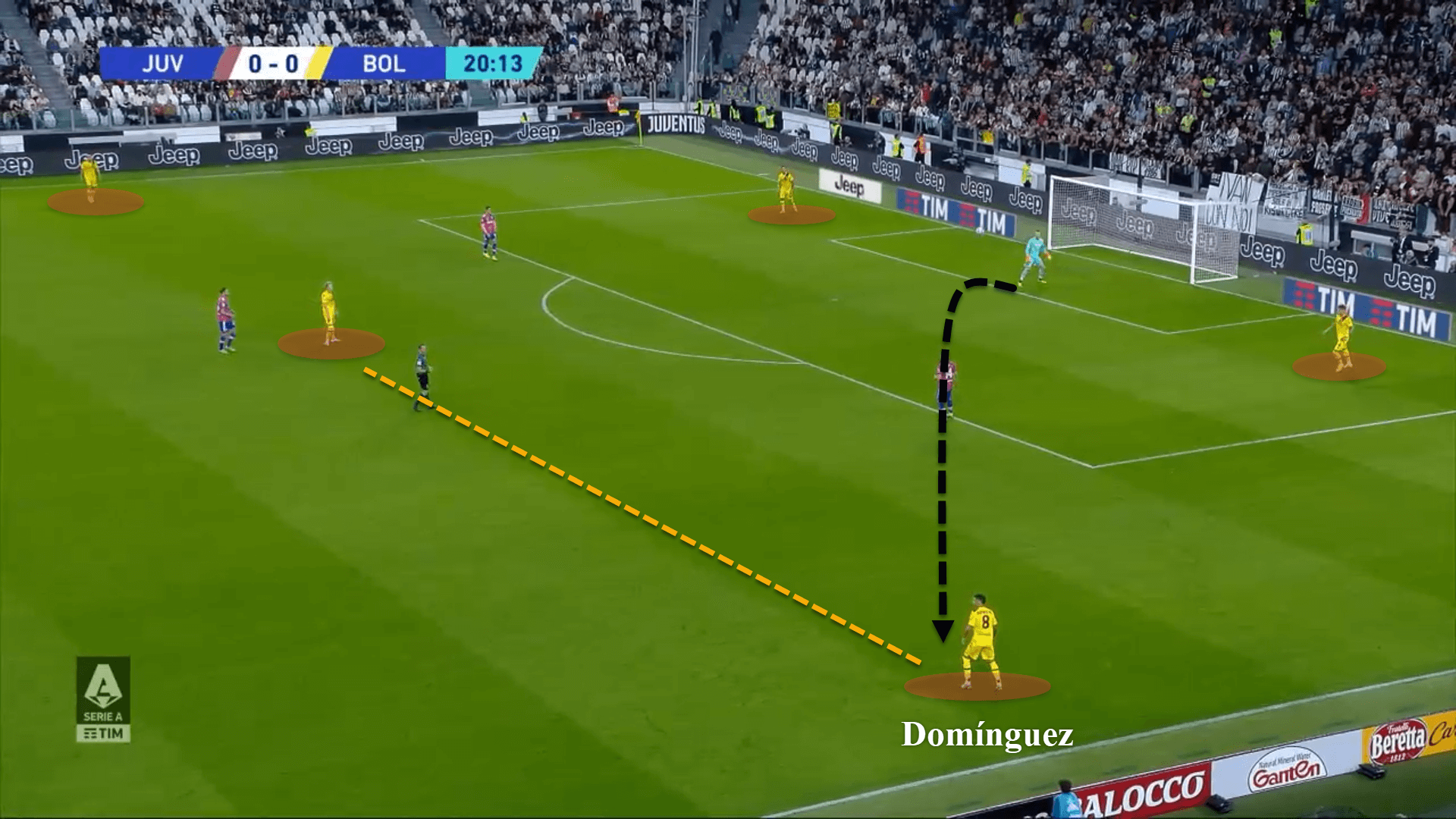
Here, Nicolás Domínguez, who was used in a double-pivot alongside Jerdy Schouten, moved out to where the fullback would normally be on the left.
The left back has advanced up the flank, taking the Juventus right-winger with him, which has afforded Domínguez time to trap the ball and move it forward before being pressurised.
Bologna’s build-up play normally goes out to the wide areas, where the team attempts to use combination play to bypass the opponent’s pressure and move forward up the pitch, particularly on the left.
The side’s passing network against Sampdoria from two weeks ago displayed this perfectly, given how heavy the links were down the flanks:
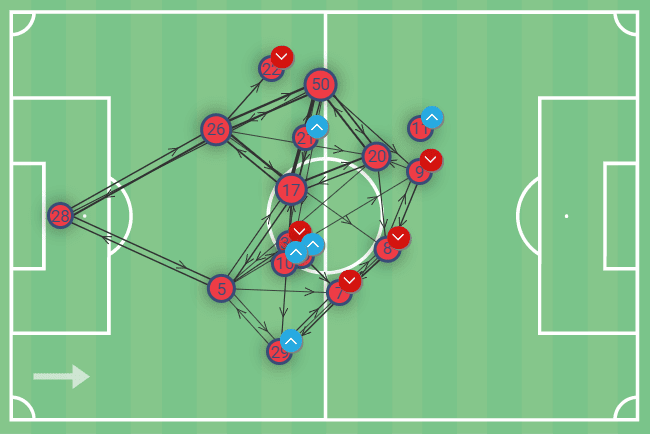
However, there are moments when playing out isn’t the best option.
Thankfully, within the team’s ranks, Motta possesses players such as Marko Arnautovic and Joshua Zirkzee, who the centre-backs and goalkeeper can play along to in order to win the initial contact during aerial duels.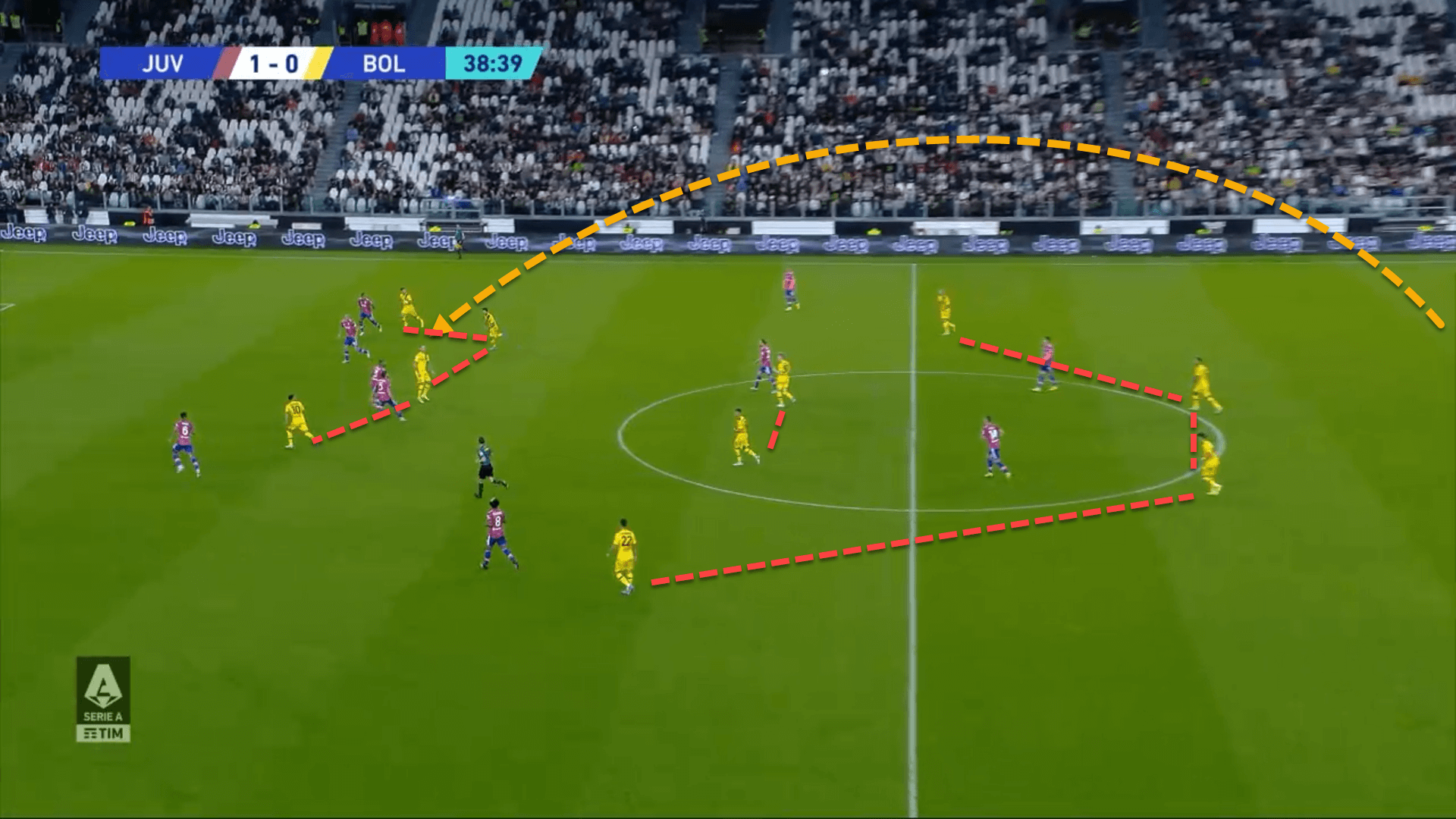
This was one distinct moment from the first half of Bologna’s 3-0 defeat to Juventus at the Allianz Stadium, where Motta signalled for Skorupski to pump it long and for his players to move up into a compact 4-2-3-1 shape to regain the second ball.
Bologna’s support structure during these scenarios is excellent.
The forward players attack the depth in flick-ons from the initial contact, while the midfielders push closer to the centre-forward to earn the second balls when they are knocked down.
While many coaches are keen on building up play from the back, using passes on the floor to bypass pressure, it is important to also realise that there are times when going more direct is a far better option.
Motta recognises this and has instructed his players to be flexible with their approach.
Thiago Motta Micro transitions
One of the most interesting aspects of Bologna’s attacking play is just how vertical the team plays when trying to break down an opponent’s defensive block.
This doesn’t mean that the Rossoblù kick it long into the channels for runners, although these types of passes do still occur.
Instead, verticality relates to how quickly Bologna moves the ball forward, constantly looking for passes between the lines.
Motta wants his players to suffocate this area of the pitch with bodies, giving the backline and deeper midfielders as many central progressive passing options as possible.
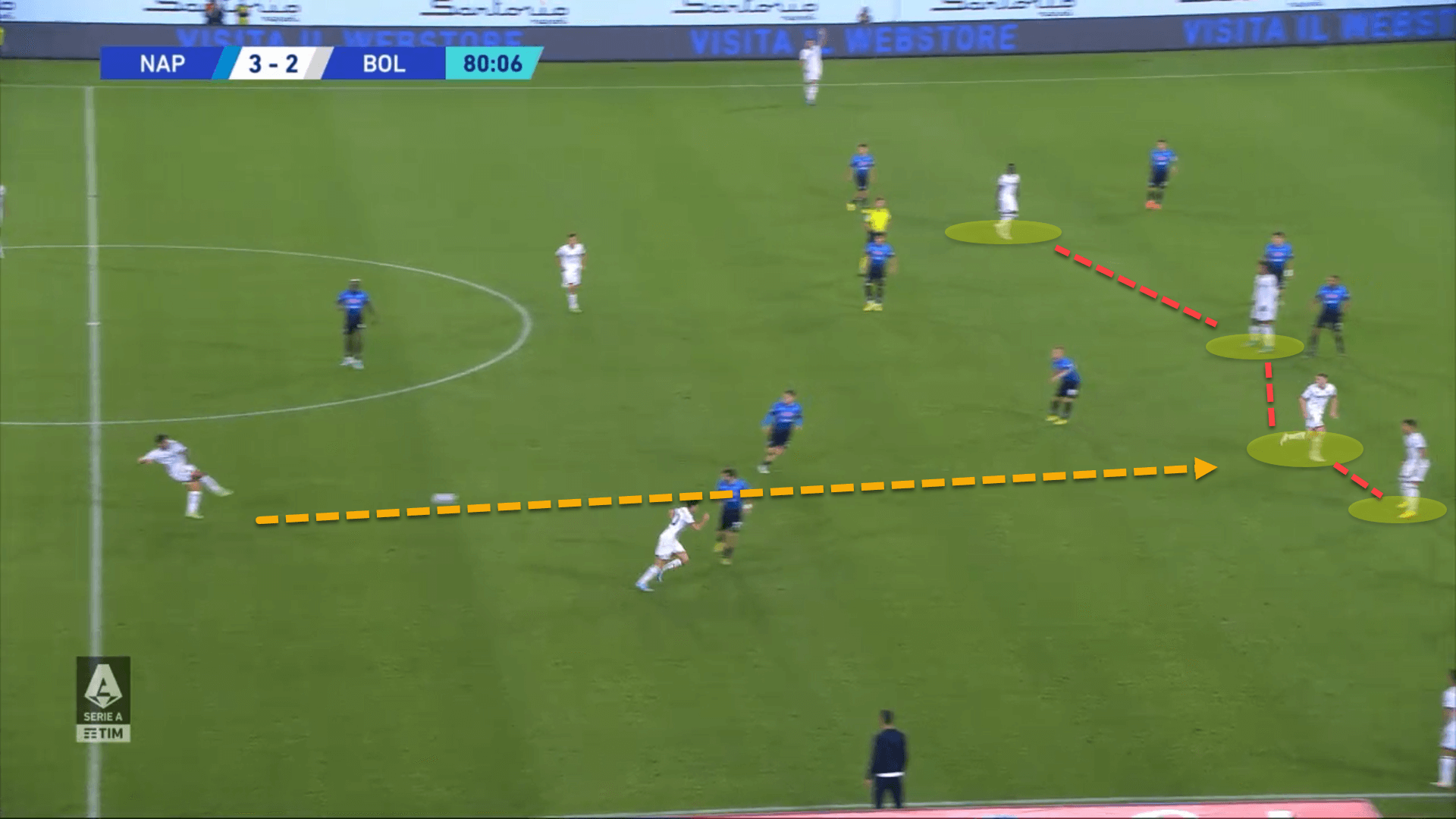
Often, Bologna keeps just one central midfielder behind the ball, who, along with the central defenders, is tasked with making penetrating passes through the lines.
Unfortunately, this can also detriment the team during defensive transitions due to the lack of players protecting the central defenders.
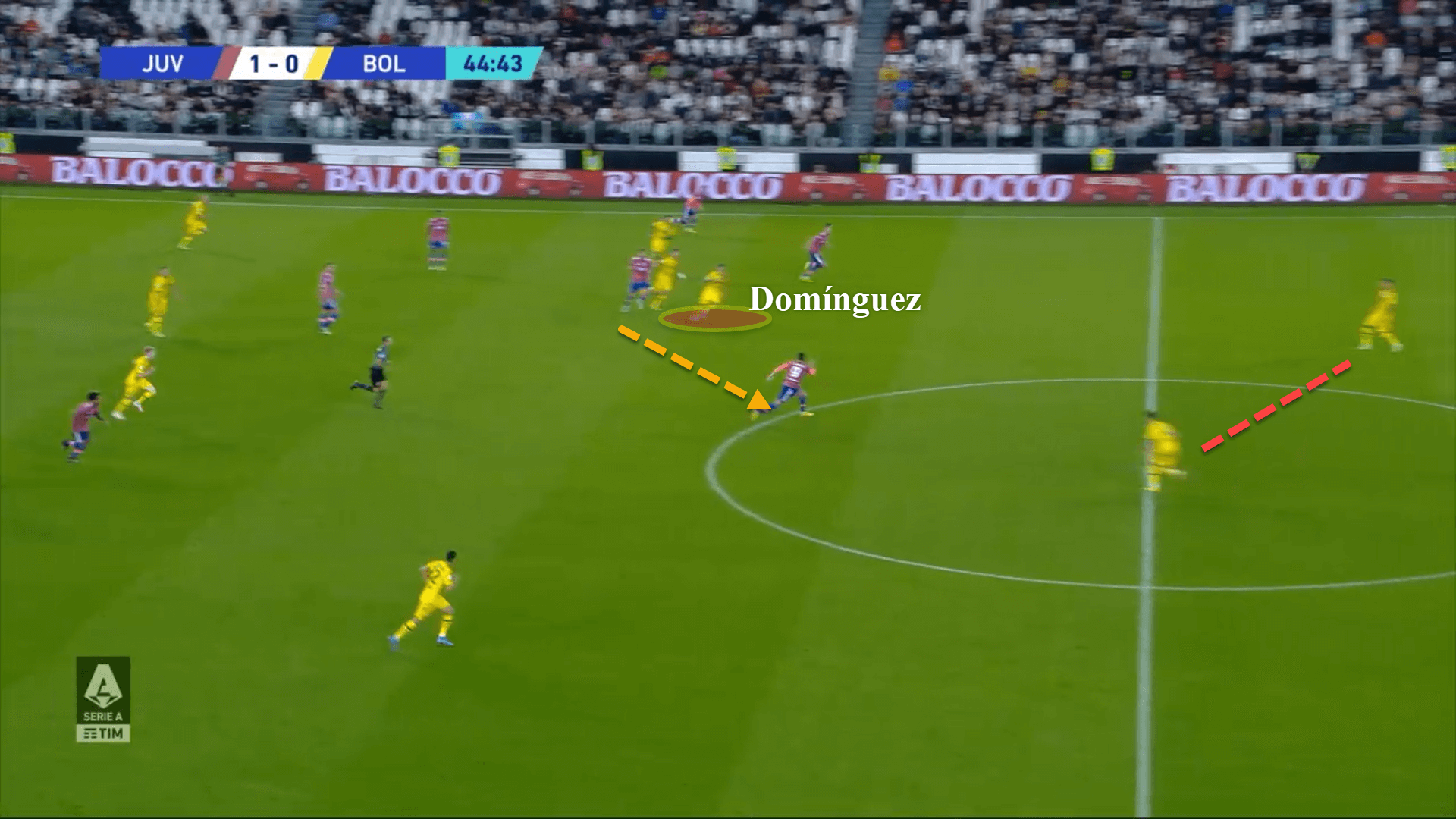
Here, Juventus almost doubled their lead due to Bologna’s risky attacking structure.
Domínguez was the only midfielder helping to move the ball around and had drifted out wide to add an extra body to a wide overload on the right.
The Bianconeri regained possession
, and since Domínguez was out of position, Juventus’ counterattack put Bologna’s two centre-backs in a highly dangerous situation.
Nevertheless, the rewards can be copious when Motta’s precarious strategy pays off.
The new manager wants his players to create micro-transitions.
Essentially, when the ball is played into between the lines, Bologna shifts the tempo up a gear, attacking the box rapidly with runners in behind and one-touch passing, causing mini transition-like scenarios.
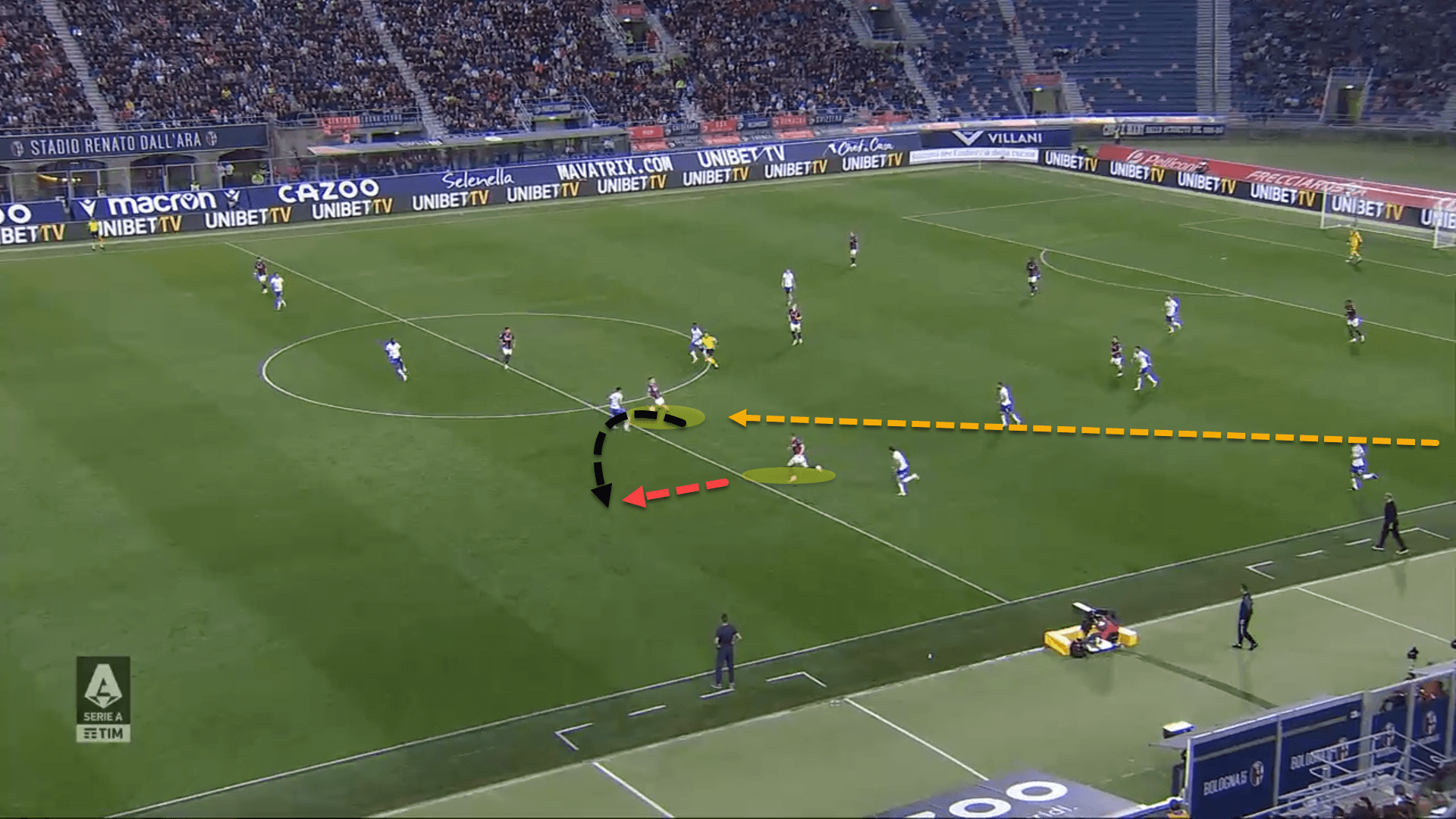
Here, Arnautovic has received the ball behind Sampdoria’s midfield.
Without trapping the ball, the Austrian makes a first-time pass around the corner to his winger who was darting in behind the backline, creating a goalscoring opportunity.
From this move, a goal was created.
These micro-transitions are deadly, as the opposition is lulled into a false sense of security about the pace of the game.
The side can kill even the best of defences by stepping up the tempo and playing one-touch passing with players making forward runs.
Thiago Motta Defensive struggles
Defensively is where Bologna have struggled the most.
There is nothing innovative about their out-of-possession style, and there doesn’t need to be, but Motta’s men look far from secure at the back, and improvements are definitely needed.
Sticking with wanting to be a progressive, modern-day coach, the Italian instructs his players to press high up the pitch to either win the ball back in the final third or else to force the opposition to play long where the centre-backs can gather it.
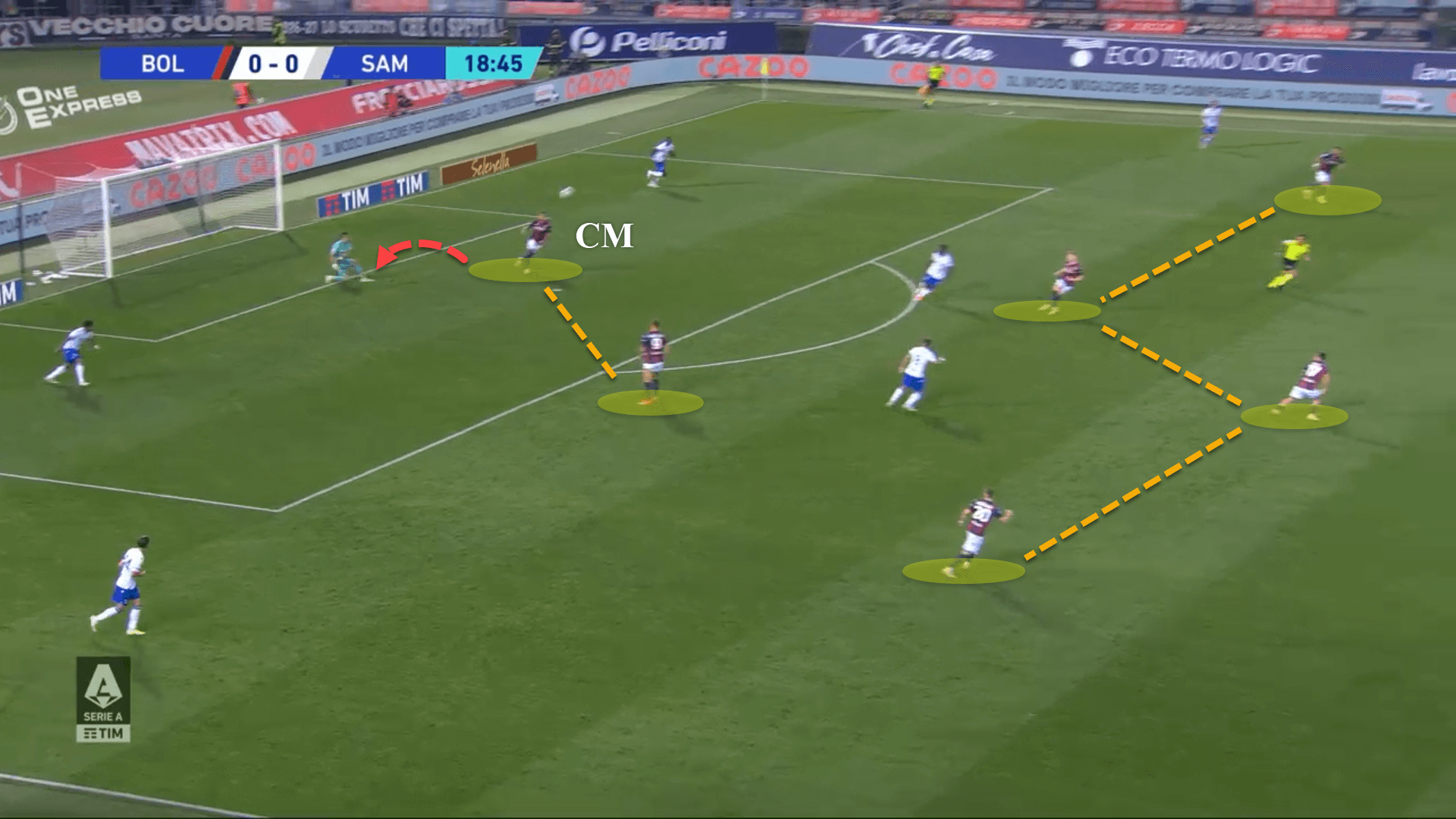
Bologna press in a 4-4-2 shape.
If Motta deploys a 4-2-3-1, the number ‘10’ will step up alongside the striker to press, but if the formation is a 4-1-4-1, one of the central midfielders will push forward and help out.
The objective is to cut off the access to one side of the pitch, causing the opposition to either play wide or else kick it long over the team’s high block.
So far, during the manager’s short reign, the Rossoblù have boasted a Passes allowed Per Defensive Action rate (PPDA) of 8.9, meaning they allow the attacking team to make roughly nine passes before trying to win it back.
There are no real issues for Bologna during this stage.
The main problems become prevalent lower down the pitch when the side drops off into a lower defensive block.
The idea is for the players to remain compact and prevent the offensive team from playing through the lines.
In theory, this is wonderful, but the execution from Bologna leaves a lot to be desired.
Often, it’s far too easy for the other side to play into the spaces between the lines.

In this instance, Juventus made merely two passes and were in behind Bologna’s backline to potentially create a clear-cut opportunity on goal.
Furthermore, the side’s low block can be highly disorganised when stepping up.
This means that, when the ball is cleared out from the defenders and the players step back up as a unit from the second phase, there are far too many gaps, which can allow the opposition to create opportunities.
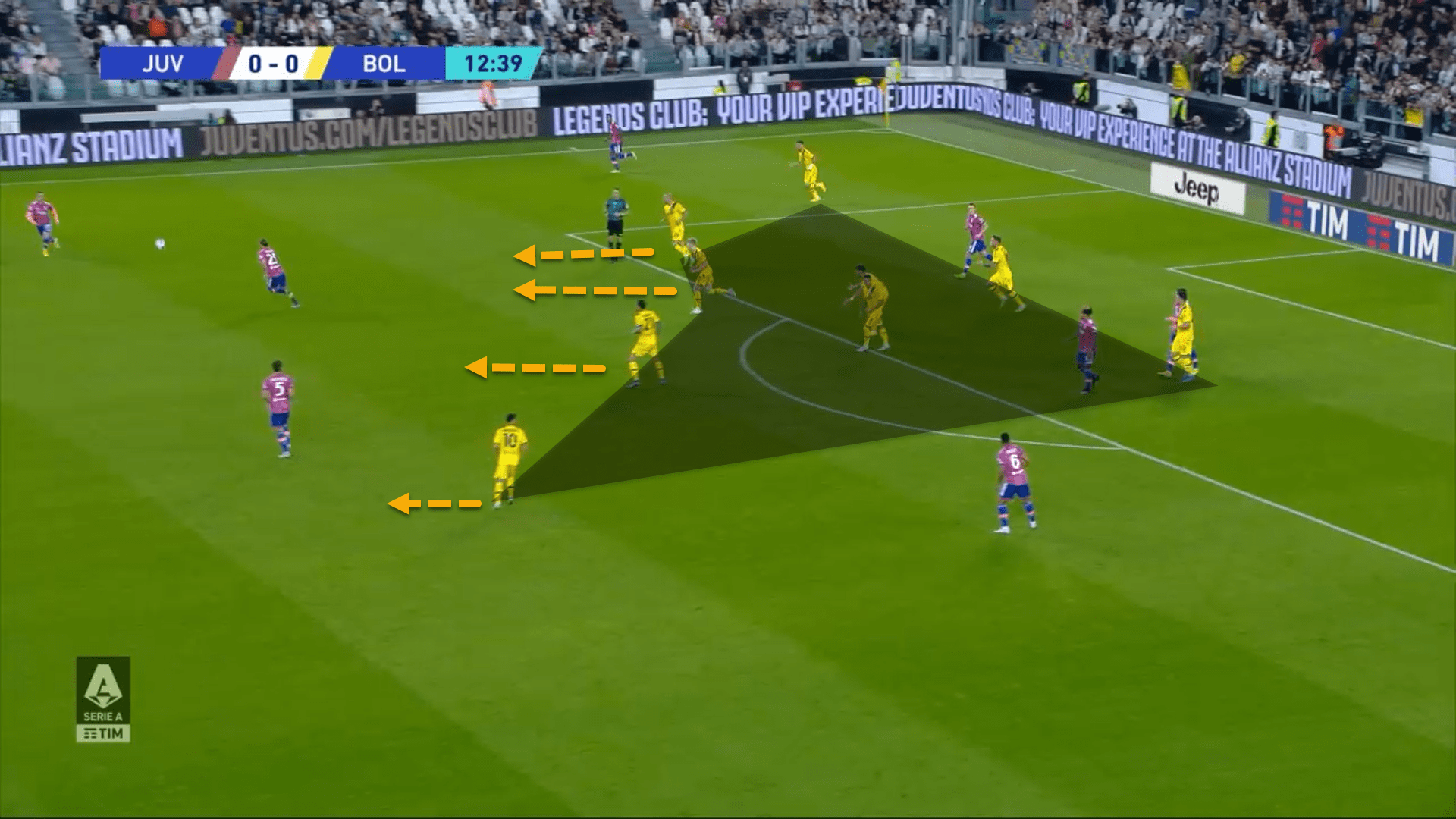
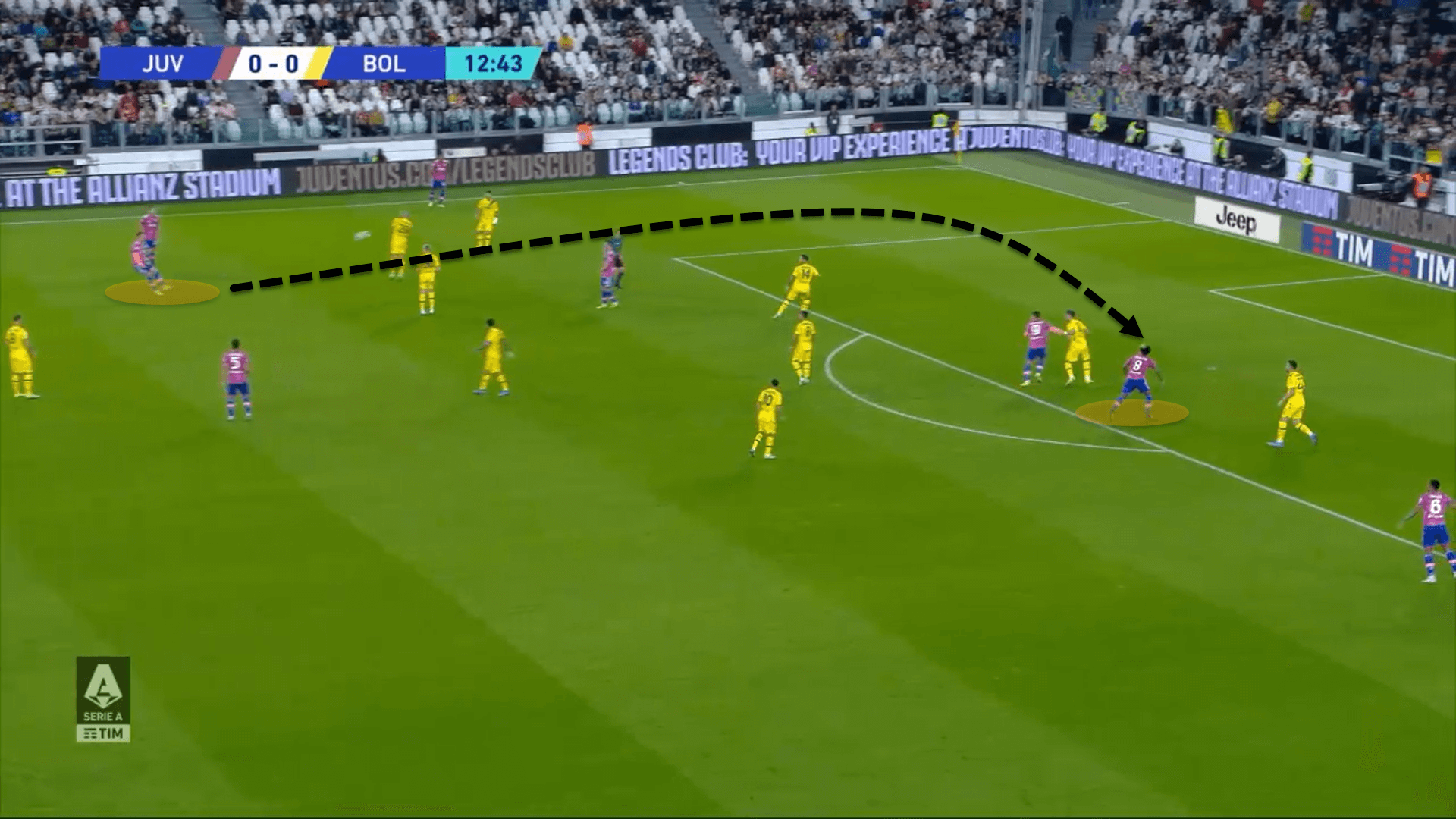
For example, here, Bologna have cleared the ball away and are attempting to restructure themselves back into a 4-4-2 low block by stepping up to the edge of the area.
However, the players fail to do so in unison and Juventus quickly play the ball into the box which allows Weston McKennie to get a free header on goal.
So far
in Motta’s reign, Bologna is conceding an average of 2.01 xG per match, which is exactly two goals per game.
Significant defensive improvements are needed.
Conclusion
Motta certainly needs more than a few matches to really impose his authority on the squad tactically.
Nevertheless, the vision is there.
The manager has already changed the shape and made the Rossoblù far more expansive.
He wants to control possession regardless of the opponent while also being flexible strategically, allowing his players to play more direct when necessary.
There is still a lot of football to be played in Serie A and so by the end of the campaign, the players may have bought into the young coach’s attacking philosophy.






Comments